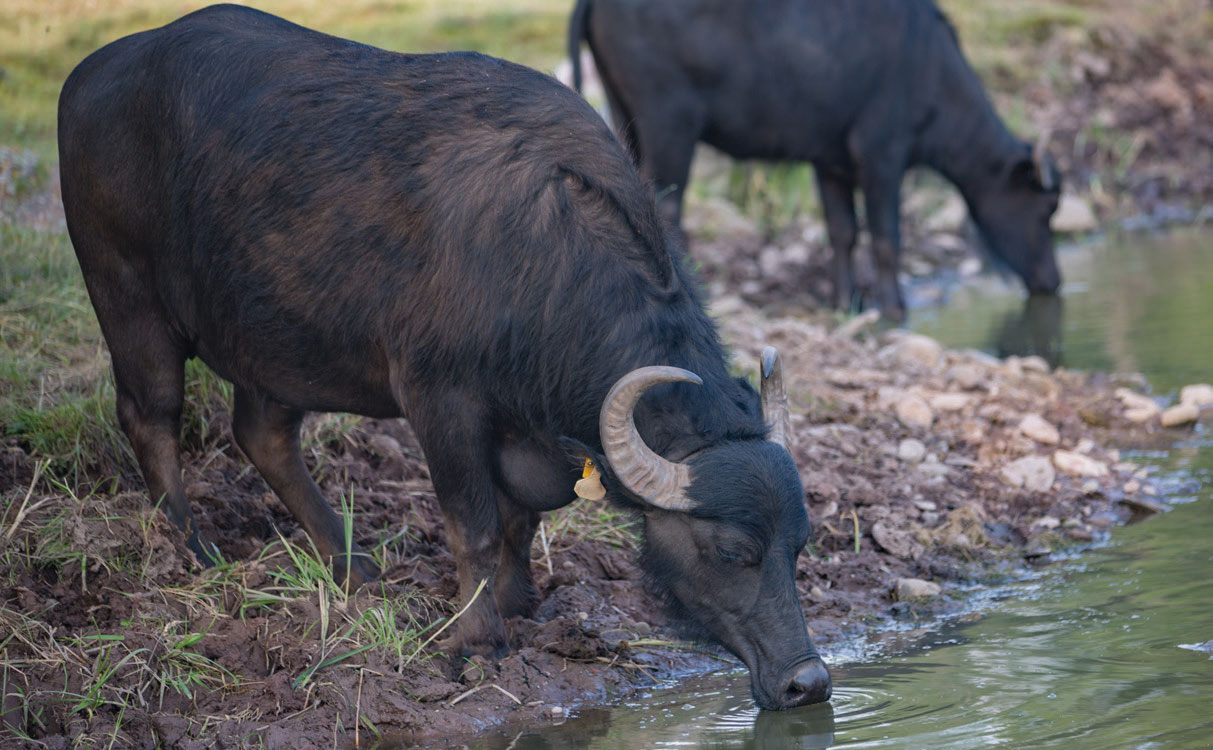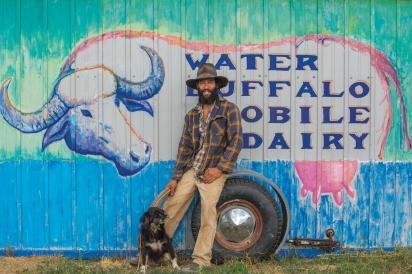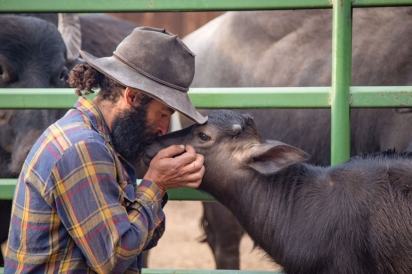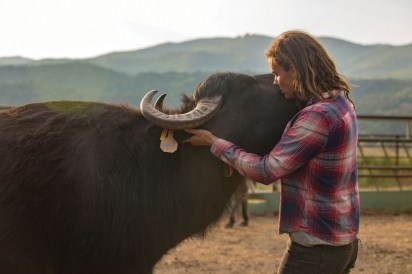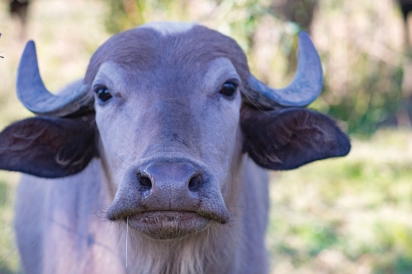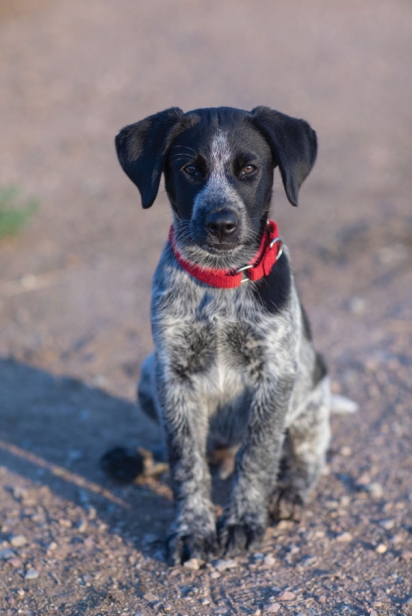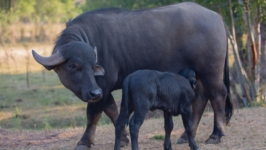Buffalo Gals
Venezuelan-born Jose Miranda puts the wheels in motion for the Western Slope’s first water buffalo dairy.
One thing becomes immediately clear while scrolling through Jose Miranda’s Rocking TT Bar Dairy Instagram feed: This is a man who loves his work.
Miranda, 42, grew up on a water buffalo dairy in Central Venezuela. He received a scholarship to Montana State University, earned a degree there in animal and range sciences, then moved to Carbondale, where he worked as a ranch hand and foreman at the historic Tybar Ranch, a cattle operation owned by Emma Danciger.
Miranda moved back to Venezuela in 2008 to start a water buffalo operation with his (now former) wife, Kami. But after four years, the ongoing political turmoil and a robbery at gunpoint prompted them to return to the United States with their two children, Kawak, 15, and Paz, 13, for good.
In 2016, Miranda decided to establish the first water buffalo dairy in the Roaring Fork Valley, using a mobile milking unit of his own design. His animals graze on pasture at Sunfire Ranch, which is owned by Jason Sewell. The buffaloes have the run of the property because they help aerate and regenerate the soil by churning it with their hooves, dispersing seeds in their manure.
Says Sewell, who also rents land to farmer Casey Piscura of Wild Mountain Seeds, “My family has a 125-year history on this land that we’re tremendously proud of and aspire to honor as we move into the future. With that in mind, we’re interested in exploring new and progressive agriculture and land management, which is how we became interested in what Jose was proposing.”
Carrying on a family legacy
Water buffalo milk is coveted for cheesemaking throughout parts of Asia, Europe, the United States and Australia, due to its high butterfat and rich, clean flavor. Miranda’s uncles introduced the first herds to Venezuela in 1976, and subsequently launched that nation’s first commercial dairy. Seeing the business potential, Miranda’s father purchased a 3,000-acre ranch outside of Caracas in 1988 and began raising buffalo and making and selling fresh cheese.
Says Miranda, “I call it the Queen of Milks. It’s very rich, but without the gamey aroma or flavor that you might find with other ruminants like goats or sheep. It’s also better digested by those with lactose intolerance.”
While the idea of raising a bovine species indigenous to tropical and subtropical lowlands in the Rockies might sound questionable (The Skyline Correctional Center in Canon City also has water buffalo as part of its Colorado Correctional Industries program), Miranda’s herd is already thriving. He started out with two calves he purchased in Texas and now has 19 buffalo, including two heifers born on the ranch last summer.
“There’s two things I’m really passionate about: genetic development and handling the animals,” Miranda says. The Rocking TT Bar are river buffalo (see sidebar, “A brief history of the water buffalo,” page 25) with genetics from Brazil, Italy and the United States. He has three bulls (Colosseum, Cacique and Equinox; every animal has a name), which helps to increase the genetic diversity of the herd.
Vigor is an important attribute in all livestock, but it’s particularly critical for these Carbondale-dwelling water buffalo. “Weather and altitude are the two challenges we have in this region,” says Miranda. “Winter gets rough—they’re prone to frostbite on the tips of their ears, just like cows.” They need shelter, although they huddle together for warmth and protection. They’re less prone to predation than cattle, he says, because buffalo “stay in tighter groups.”
In general, however, water buffalo are an extremely hardy, resilient species, more resistant to disease and parasites than cattle and able to “thrive on rough pasture and are more adept at converting that forage to energy,” says Miranda. “They eat plants that cattle find less palatable and are better able to digest them due to having a higher concentration of beneficial bacteria in their rumens.”
The herd grazes on sage, juniper, pinon and cheatgrass on the hillsides; in summer, they’re pastured in the valley portion of the ranch where they also have access to a pond. “They don’t actually require water to swim in,” Miranda says.
Building a better dairy
The cows will be 3 years old when Miranda begins milking them, but from birth his main objective is to handle the calves and adults as much as possible to bond with and train them for milking. “Water buffalo are a docile species,” he says, “and naturally curious. They’re also gentle with each other—they take turns being petted. Raising them this way, I don’t need to work them using horses. They’re halter-trained, and I can pick up their hooves and trim them in the field.”
The connection Miranda shares with his herd is entirely mutual. On his daily drives into the field to check on the animals, “they see my truck and come up to me, but they’ll also come when I call them. Even the adult animals I’ve purchased quickly catch on to herd dynamics and develop an attachment to me. They’re like pets, with regard to their behavior.”
That said, Miranda is fully aware that these 1,000-pound beasts can be as unpredictable as any other species. Says his girlfriend, Erin Cuseo of Erin’s Acres, “I enjoy watching him interact with the buffaloes because he knows each one of them personally. Their relationships are based on mutual respect as much as trust. They’re such a unique animal, with such emotional intelligence. They’ll roll over on their sides so we can remove ticks and burrs from them.”
Miranda’s mobile milking unit came about after he saw photos of a similar design being used on a cow dairy in the Azores Islands. Danciger donated an old, 8- by 20-foot cattle trailer to Miranda and with the help of Carbondale’s Green Line Architects he modified the unit to include solar (to power two milking machines), a radio and a wood stove to provide warmth. The trailer has no floor, but rather, a hydraulic wheel system. After milking is completed, the unit can be towed away, reducing impact on the soil.
The benefits don’t stop there. “It’s also clean,” says Miranda. “Unlike a stationary milking parlor, it’s not kept around manure, so the parasite load is lower. It’s also better for the health of the land and animals—their waste fertilizes the soil and it reduces stress on them because they’re able to remain in pasture.”
“I want to make the idea of the milking unit public and offer consulting on design and mobile dairy management, to encourage young farmers wanting to get into this aspect of agriculture,” he says. “It will show them that they have options to getting the necessary [and costly] permits for a permanent milking parlor. This way, you can rent land and move the unit as needed. I also want to encourage ranchers to raise water buffalo in Colorado and help them with the logistics.”
Miranda is currently experimenting with making mozzarella; he’s already had interest from a number of local chefs wanting to purchase the milk and cheese when the creamery phase of his business launches next summer. His own creamery is still two years off, but in the meantime there’s plenty of work to be done.
For now, Miranda is content to focus on growing and improving his herd and spending quality time with his animals (afternoon naps lying against the comforting bulk of a cow are a regular occurrence). “It was really hard [leaving Venezuela],” he says, slowly. “Getting back to raising water buffalo is really important to me—I never thought it would happen. Now, I feel really at peace.”
GO FIND IT!
TT Rocking Bar Dairy
For more information, call 970.615.0098
Tours are offered on Saturdays only, reservations required.


